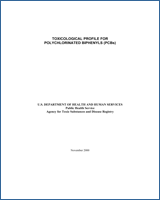NCBI Bookshelf. A service of the National Library of Medicine, National Institutes of Health.
Toxicological Profile for Polychlorinated Biphenyls (PCBs). Atlanta (GA): Agency for Toxic Substances and Disease Registry (US); 2000 Nov.
Toxicological Profiles are a unique compilation of toxicological information on a given hazardous substance. Each profile reflects a comprehensive and extensive evaluation, summary, and interpretation of available toxicologic and epidemiologic information on a substance. Health care providers treating patients potentially exposed to hazardous substances will find the following information helpful for fast answers to often-asked questions.
Primary Chapters/Sections of Interest
- Chapter 1: Public Health Statement: The Public Health Statement can be a useful tool for educating patients about possible exposure to a hazardous substance. It explains a substance’s relevant toxicologic properties in a nontechnical, question-and-answer format, and it includes a review of the general health effects observed following exposure.
- Chapter 2: Relevance to Public Health: The Relevance to Public Health Section evaluates, interprets, and assesses the significance of toxicity data to human health.
- Chapter 3: Health Effects: Specific health effects of a given hazardous compound are reported by type of health effect (death, systemic, immunologic, reproductive), by route of exposure, and by length of exposure (acute, intermediate, and chronic). In addition, both human and animal studies are reported in this section.
- NOTE: Not all health effects reported in this section are necessarily observed in the clinical setting. Please refer to the Public Health Statement to identify general health effects observed following exposure.
- Pediatrics: Four new sections have been added to each Toxicological Profile to address child health issues:
- Section 1.6 How Can (Chemical X) Affect Children?
- Section 1.7 How Can Families Reduce the Risk of Exposure to (Chemical X)?
- Section 3.7 Children’s Susceptibility
- Section 6.6 Exposures of Children
- Other Sections of Interest:
- Section 3.8 Biomarkers of Exposure and Effect
- Section 3.11 Methods for Reducing Toxic Effects
ATSDR Information Center
- Phone: 1-888-42-ATSDR or (404) 639-6357
- E-mail: vog.cdc@cirdsta
- Fax: (404) 639-6359
- Internet: http://www.atsdr.cdc.gov
The following additional material can be ordered through the ATSDR Information Center:
- Case Studies in Environmental Medicine: Taking an Exposure History—The importance of taking an exposure history and how to conduct one are described, and an example of a thorough exposure history is provided. Other case studies of interest include Reproductive and Developmental Hazards; Skin Lesions and Environmental Exposures; Cholinesterase-Inhibiting Pesticide Toxicity; and numerous chemical-specific case studies.
- Managing Hazardous Materials Incidents is a three-volume set of recommendations for on-scene (prehospital) and hospital medical management of patients exposed during a hazardous materials incident. Volumes I and II are planning guides to assist first responders and hospital emergency department personnel in planning for incidents that involve hazardous materials. Volume III—Medical Management Guidelines for Acute Chemical Exposures—is a guide for health care professionals treating patients exposed to hazardous materials.
- Fact Sheets (ToxFAQs) provide answers to frequently asked questions about toxic substances.
Other Agencies and Organizations
- The National Center for Environmental Health (NCEH) focuses on preventing or controlling disease, injury, and disability related to the interactions between people and their environment outside the workplace. Contact: NCEH, Mailstop F-29, 4770 Buford Highway, NE, Atlanta, GA 30341-3724 • Phone: 770-488-7000 • FAX: 770-488-7015.
- The National Institute for Occupational Safety and Health (NIOSH) conducts research on occupational diseases and injuries, responds to requests for assistance by investigating problems of health and safety in the workplace, recommends standards to the Occupational Safety and Health Administration (OSHA) and the Mine Safety and Health Administration (MSHA), and trains professionals in occupational safety and health. Contact: NIOSH, 200 Independence Avenue, SW, Washington, DC 20201 • Phone: 800-356-4674 or NIOSH Technical Information Branch, Robert A. Taft Laboratory, Mailstop C-19, 4676 Columbia Parkway, Cincinnati, OH 45226-1998 • Phone: 800-35-NIOSH.
- The National Institute of Environmental Health Sciences (NIEHS) is the principal federal agency for biomedical research on the effects of chemical, physical, and biologic environmental agents on human health and well-being. Contact: NIEHS, PO Box 12233, 104 T.W. Alexander Drive, Research Triangle Park, NC 27709 • Phone: 919-541-3212.
Referrals
- The Association of Occupational and Environmental Clinics (AOEC) has developed a network of clinics in the United States to provide expertise in occupational and environmental issues. Contact: AOEC, 1010 Vermont Avenue, NW, #513, Washington, DC 20005 • Phone: 202-347-4976 • FAX: 202-347-4950 • e-mail: moc.sysgd.sgd@ceoa • AOEC Clinic Director: http://occ-env-med.mc.duke.edu/oem/aoec.htm.
- The American College of Occupational and Environmental Medicine (ACOEM) is an association of physicians and other health care providers specializing in the field of occupational and environmental medicine. Contact: ACOEM, 55 West Seegers Road, Arlington Heights, IL 60005 • Phone: 847-228-6850 • FAX: 847-228-1856.
- QUICK REFERENCE FOR HEALTH CARE PROVIDERS - Toxicological Profile for Polychlori...QUICK REFERENCE FOR HEALTH CARE PROVIDERS - Toxicological Profile for Polychlorinated Biphenyls (PCBs)
- ACRONYMS, ABBREVIATIONS, AND SYMBOLS - Toxicological Profile for Polychlorinated...ACRONYMS, ABBREVIATIONS, AND SYMBOLS - Toxicological Profile for Polychlorinated Biphenyls (PCBs)
Your browsing activity is empty.
Activity recording is turned off.
See more...
